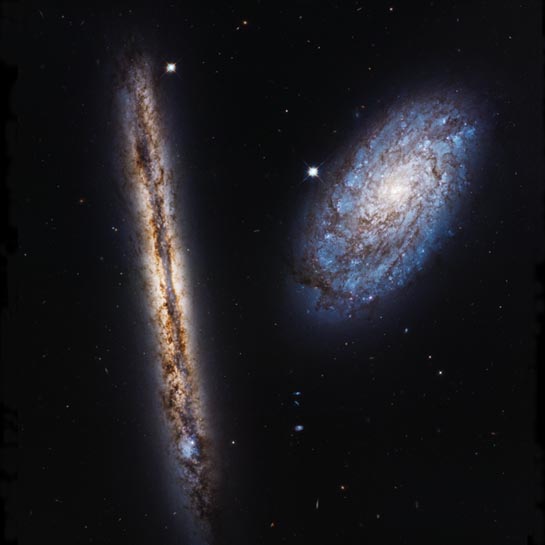
Interacting Galaxies
4298- RA 12h 21m 32.790s Dec +14° 36' 21.78"
4302- RA 12h 21m 42.477s Dec +14° 35' 51.94"
Coma Berenices
55 million light years
F475W (B), F555W (V), and F625W (r)
NASA, ESA, and M. Mutchler (STScI)
April 20, 2017
ABOUT THIS IMAGE:
This stunning cosmic pairing of the two very different looking spiral galaxies NGC 4302 and NGC 4298 was imaged by the NASA/ESA Hubble Space Telescope. The image brilliantly captures their warm stellar glow and brown, mottled patterns of dust. As a perfect demonstration of Hubble's capabilities, this spectacular view has been released as part of the telescope's 27th anniversary celebrations.
Since its launch on April 24, 1990, Hubble has been nothing short of a revolution in astronomy. The first orbiting facility of its kind, for 27 years the telescope has been exploring the wonders of the cosmos. Astronomers and the public alike have witnessed what no other humans in history have before. In addition to revealing the beauty of the cosmos, Hubble has proved itself to be a treasure chest of scientific data that astronomers can access.
ESA and NASA celebrate Hubble's birthday each year with a spectacular image. This year's anniversary image features a pair of spiral galaxies known as NGC 4302 - seen edge-on - and NGC 4298, both located 55 million light-years away in the northern constellation of Coma Berenices (Berenice's Hair). The pair, discovered by astronomer William Herschel in 1784, form part of the Virgo Cluster, a gravitationally bound collection of nearly 2000 individual galaxies.
The edge-on galaxy is called NGC 4302, and the tilted galaxy is NGC 4298. These galaxies look quite different because we see them angled at different positions on the sky. They are actually very similar in terms of their structure and contents.
From our view on Earth, researchers report an inclination of 90 degrees for NGC 4302, which is exactly edge on. NGC 4298 is tilted 70 degrees.
A typical spiral galaxy has arms of young stars that wind outward from its center. The bright arms are regions of intense star formation. Such galaxies have a central bulge and are surrounded by a faint halo of stars. Many spiral galaxies also have bars that extend from the central bulge to the arms
In NGC 4298, the telltale, pinwheel-like structure is visible, but it's not as prominent as in some other spiral galaxies. It is about 45,000 light-years in diameter, about one third the size of the Milky Way. At 17 billion solar masses, it is less than 2 percent of the Milky Way galaxy's 1 trillion solar masses.
In the edge-on NGC 4302, dust in the disk is silhouetted against rich lanes of stars. Absorption by dust makes the galaxy appear darker and redder than its companion. A large blue patch to the left side of the galaxy appears to be a giant region of recent star formation. The galaxy is about 87,000 light-years in diameter, which is about 60 percent the size of the Milky Way. It is about 110 billion solar masses, approximately one-tenth of the Milky Way's mass. The tilted NGC
At their closest points, the galaxies are separated from each other in projection by only around 7000 light-years. Given this very close arrangement, astronomers are intrigued by the galaxies' apparent lack of any significant gravitational interaction; only a faint bridge of neutral hydrogen gas - not visible in this image - appears to stretch between them. The long tidal tails and deformations in their structure that are typical of galaxies lying so close to each other are missing completely.
Astronomers have found very faint tails of gas streaming from the two galaxies, pointing in roughly the same direction - away from the center of the Virgo Cluster. They have proposed that the galactic double is a recent arrival to the cluster, and is currently falling in towards the cluster center and the galaxy Messier 87 lurking there - one of the most massive galaxies known. On their travels, the two galaxies are encountering hot gas - the intracluster medium - that acts like a strong wind, stripping layers of gas and dust from the galaxies to form the streaming tails.
The image is a mosaic of four separate captures from Hubble, taken between 2 and 22 January 2017, that have been stitched together to give this amazing field of view. Two different types of light emitted by the galaxies - visible and near-infrared - have been combined to give a rich and colorful image. This light was captured by Hubble's Wide Field Camera 3, one of the telescope's most advanced imaging instruments.
Even
in its 27th year of operation, Hubble continues to provide truly spectacular
images of the cosmos, and even as the launch date of its companion - the
NASA/ESA/CSA James Webb Space Telescope - draws closer, Hubble does not
slow down. Instead, the telescope keeps raising the bar, showing it still
has plenty of observing left to do for many more years to come. In fact,
astronomers are looking forward to have Hubble and James Webb operational
at the same time and use their combined capabilities to explore the Universe.